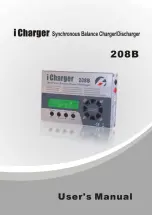
-13-
iCharger Synchronous Balance Charger/Discharger 208B
Lithium battery program
The
iCharger
provides a number of Lithium programs including Balance, Normal, Fast and Storage. Only the
Balance mode requires the balance lead connected. However, the other modes will provide additional
per-cell over-voltage protection if the balance lead is connected compared to running them without it, where
they can only utilize the total pack voltage.
Balance
connector
required
Balancer
active
Charge termination condition
Balance
–
Normal
Yes
Yes
Icv = Icc/10 OR Vout = (cell_count x cell_max_voltage) + Vloss
Balance
–
Fast
Yes
Yes
Icv = Icc/5 OR Vout = (cell_count x cell_max_voltage) + Vloss
Balance
–
Slow
Yes
Yes
Icv = Icc/40 OR Vout = (cell_count x cell_max_v Vloss
Charge
Optional
No
Icv = Icc/10 AND Vout = cell_count x cell_max_voltage
Fast Charge
Optional
No
Icv = Icc/5 AND Vout = cell_count x cell_max_voltage
Storage
Optional
No
Vout = cell_count x cell_storage_voltage
Cycle - charge
Optional
No
Icv = Icc/10 AND Vout = cell_count x cell_max_voltage
Cycle - discharge
Optional
No
Vout = cell_count x cell_discharge_voltage
Icc = configured charge current for the CC phase
Icv = charge current during the CV phase
cell_max_voltage = configured termination voltage for the selected chemistry (eg LiPo = 4.2V)
cell_storage_voltage = configured per-cell storage voltage for the selected chemistry
cell_discharge_voltage = configured per-cell storage voltage for the selected chemistry
Icv = charge current during the CV phase
Vloss = 0.2 * ( 1 + Icv/10A ); when in balance charging, charging line loss will compensate voltage.
Any time the battery‘s balance lead is connected the charger will monitor and display the cell voltages.
The balancer is only active during a BALANCE charge (not during the CHARGE or FAST programs)
The balance speed setting (Slow, Normal, Fast) controls the end-of-charging current threshold.
The CHARGE and FAST modes are identical except for the charge-termination threshold which is 1/10
of the charge current setting for CHARGE and 1/5 of the charge current setting for FAST mode.
While the CHARGE and FAST modes do not include any balancing action it is still safer to have the
balance lead connected since then the charger will provide per-cell over-voltage protection as described
below.
In all kinds of charge cycle, if the balance lead is connected and if any cell exceeds the allowable per-cell
peak voltage for the configured chemistry, the charge current will be reduced to ensure the voltage does
not rise any further. This will slow the charging process and if the charge current falls to 1/10 of the
charge current setting this will result in the charge cycle stopping altogether. Note that this is not the
normal CC-to-CV transition which would usually occur when all cells approach the nominal peak voltage
for the configured chemistry, but is a safety measure to respond to unbalanced cells in any mode or at
any time during the charge process.
Note:
When Li batteries are in balance charging, charger's max output voltage = (cell_count x
cell_max_voltage) + Vloss
When connecting the Li batteries with main output port and the balance port, the
charger will check cell count automatically, and forbid changing cell count setting
by user himself. This is useful for all Li batteries‘ charging and discharging mode.
Summary of Contents for 208B
Page 1: ......














































